Overview
You all remember the nostalgic Snake game on old Nokia phones. Sometimes you miss these games, but you are not able to access Nokia phones to play the game. In this case, you can easily make this game for yourself and enjoy it with an Arduino board and an LCD.
As you remember, the snake grew bigger and bigger with food, and the game continued until the snake hit itself. The bigger the snake, the harder it would be to continue playing and controlling it, as well as the higher your record.
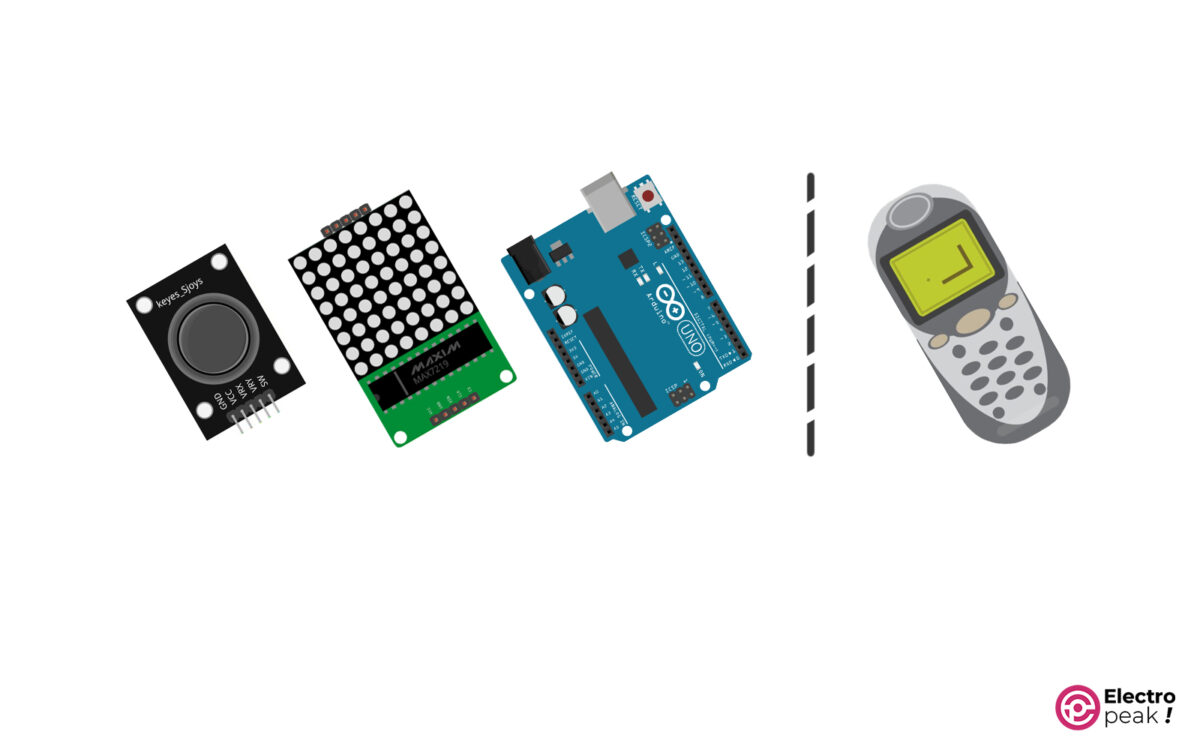
What You Will Learn
As mentioned, in this tutorial, we are going to simulate the Nokia phone’s Snake game with the Arduino board. We also use a joystick and an LCD to do this. There are two different displays to make the game:
• MAX7219 8×8 Dot Matrix Display Module
• 1602 Character LCD
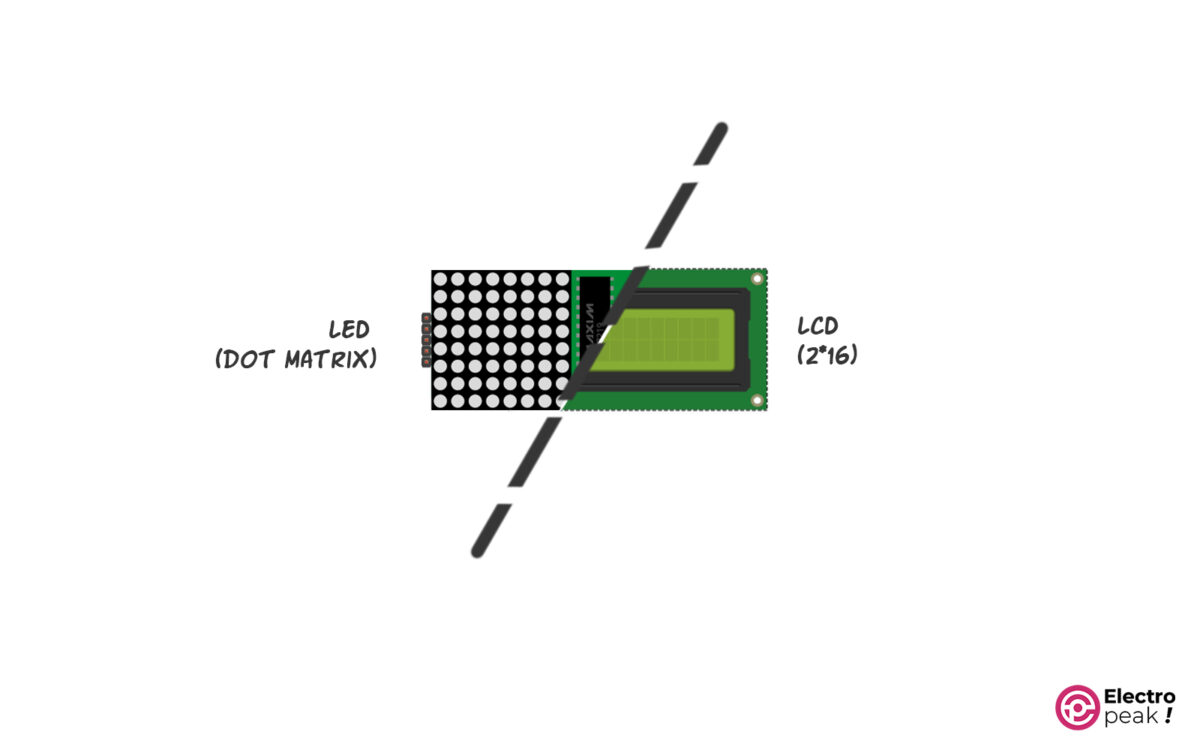
Required Materials
You need the following components to continue the tutorial:
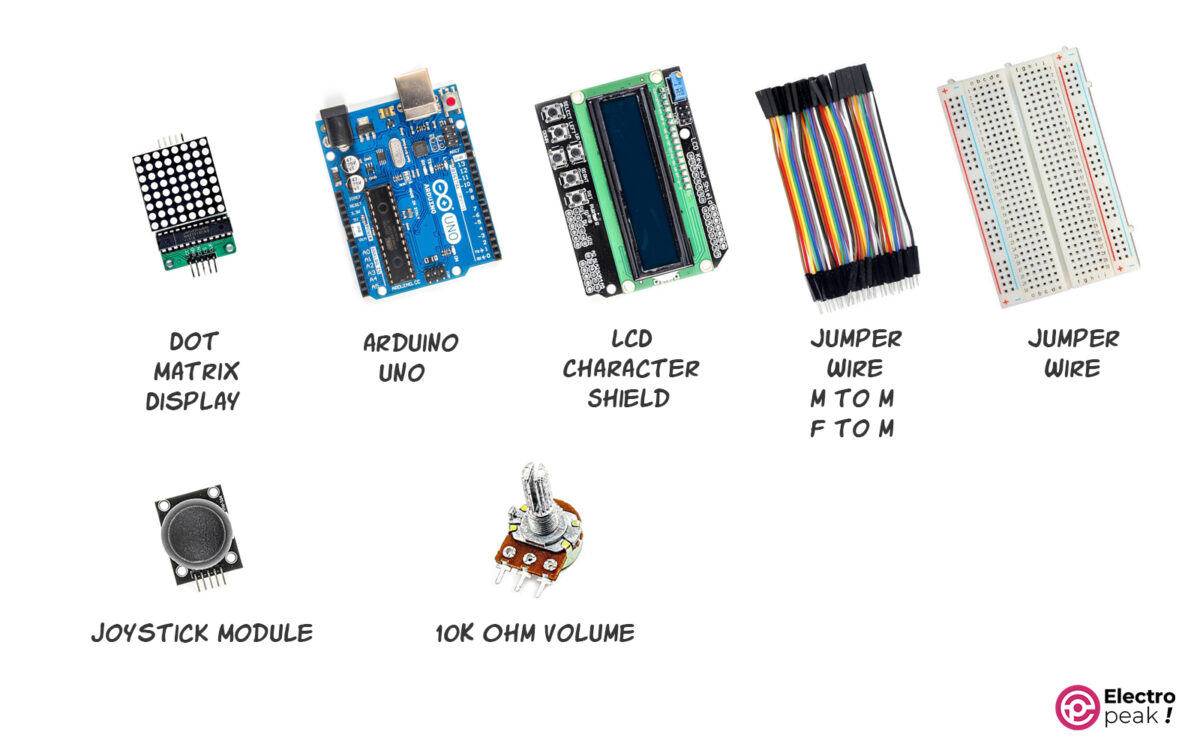
Hardware Components
Software Apps
Running the Snake Game with Arduino and MAX7219 Dot Matrix Display
Step 1: Circuit
First, connect the components to the Arduino as shown below.
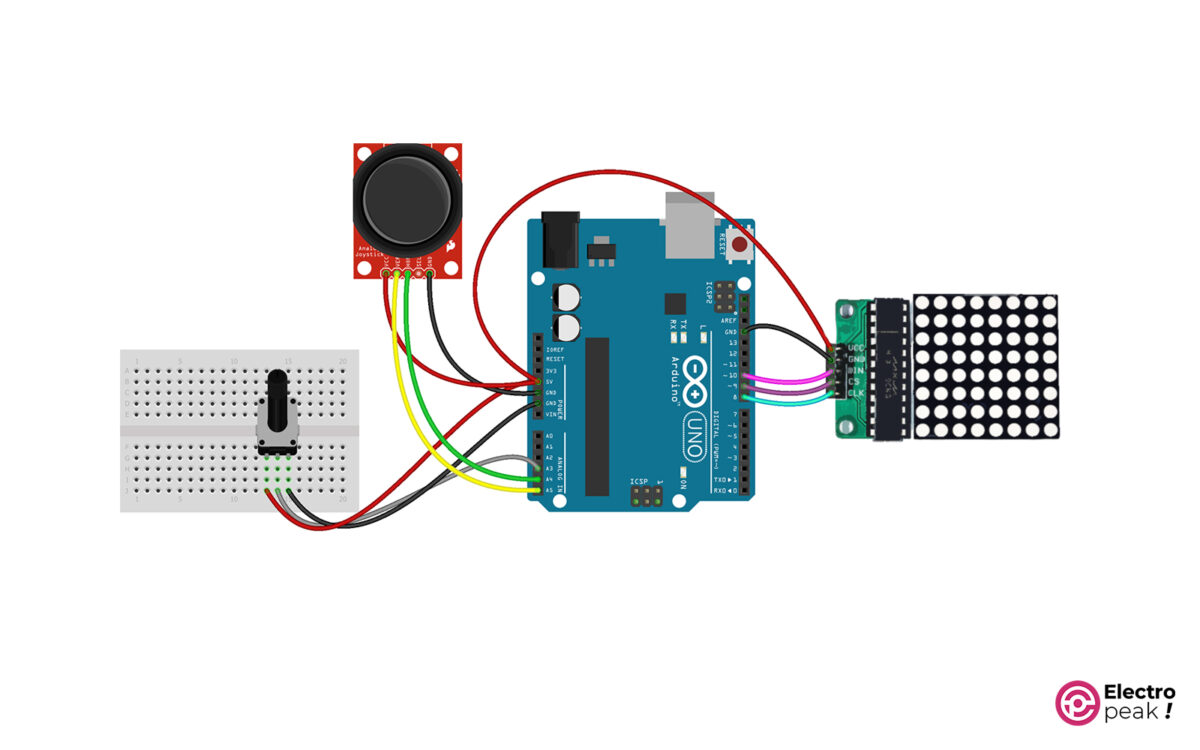
The faster you set the game, the harder it becomes.
Step 2: Code
Then, after connecting the Arduino Board to the computer, upload the following code to it:
/*
Made on 01 Sep 2021
Home
*/
#include "LedControl.h" // LedControl library is used for controlling a LED matrix. Find it using Library Manager or download zip here: https://github.com/wayoda/LedControl
// there are defined all the pins
struct Pin {
static const short joystickX = A5; // joystick X axis pin
static const short joystickY = A4; // joystick Y axis pin
static const short joystickVCC = 1; // virtual VCC for the joystick (Analog 1) (to make the joystick connectable right next to the arduino nano)
static const short joystickGND = 2; // virtual GND for the joystick (Analog 0) (to make the joystick connectable right next to the arduino nano)
static const short potentiometer = A3; // potentiometer for snake speed control
static const short CLK = 8; // clock for LED matrix
static const short CS = 9; // chip-select for LED matrix
static const short DIN = 10; // data-in for LED matrix
};
// LED matrix brightness: between 0(darkest) and 15(brightest)
const short intensity = 8;
// lower = faster message scrolling
const short messageSpeed = 5;
// initial snake length (1...63, recommended 3)
const short initialSnakeLength = 3;
void setup() {
Serial.begin(115200); // set the same baud rate on your Serial Monitor
initialize(); // initialize pins & LED matrix
calibrateJoystick(); // calibrate the joystick home (do not touch it)
showSnakeMessage(); // scrolls the 'snake' message around the matrix
}
void loop() {
generateFood(); // if there is no food, generate one
scanJoystick(); // watches joystick movements & blinks with food
calculateSnake(); // calculates snake parameters
handleGameStates();
// uncomment this if you want the current game board to be printed to the serial (slows down the game a bit)
// dumpGameBoard();
}
// --------------------------------------------------------------- //
// -------------------- supporting variables --------------------- //
// --------------------------------------------------------------- //
LedControl matrix(Pin::DIN, Pin::CLK, Pin::CS, 1);
struct Point {
int row = 0, col = 0;
Point(int row = 0, int col = 0): row(row), col(col) {}
};
struct Coordinate {
int x = 0, y = 0;
Coordinate(int x = 0, int y = 0): x(x), y(y) {}
};
bool win = false;
bool gameOver = false;
// primary snake head coordinates (snake head), it will be randomly generated
Point snake;
// food is not anywhere yet
Point food(-1, -1);
// construct with default values in case the user turns off the calibration
Coordinate joystickHome(500, 500);
// snake parameters
int snakeLength = initialSnakeLength; // chosen by the user in the config section
int snakeSpeed = 1; // will be set according to potentiometer value, cannot be 0
int snakeDirection = 0; // if it is 0, the snake does not move
// direction constants
const short up = 1;
const short right = 2;
const short down = 3; // 'down - 2' must be 'up'
const short left = 4; // 'left - 2' must be 'right'
// threshold where movement of the joystick will be accepted
const int joystickThreshold = 160;
// artificial logarithmity (steepness) of the potentiometer (-1 = linear, 1 = natural, bigger = steeper (recommended 0...1))
const float logarithmity = 0.4;
// snake body segments storage
int gameboard[8][8] = {};
// --------------------------------------------------------------- //
// -------------------------- functions -------------------------- //
// --------------------------------------------------------------- //
// if there is no food, generate one, also check for victory
void generateFood() {
if (food.row == -1 || food.col == -1) {
// self-explanatory
if (snakeLength >= 64) {
win = true;
return; // prevent the food generator from running, in this case it would run forever, because it will not be able to find a pixel without a snake
}
// generate food until it is in the right position
do {
food.col = random(8);
food.row = random(8);
} while (gameboard[food.row][food.col] > 0);
}
}
// watches joystick movements & blinks with food
void scanJoystick() {
int previousDirection = snakeDirection; // save the last direction
long timestamp = millis();
while (millis() < timestamp + snakeSpeed) {
// calculate snake speed exponentially (10...1000ms)
float raw = mapf(analogRead(Pin::potentiometer), 0, 1023, 0, 1);
snakeSpeed = mapf(pow(raw, 3.5), 0, 1, 10, 1000); // change the speed exponentially
if (snakeSpeed == 0) snakeSpeed = 1; // safety: speed can not be 0
// determine the direction of the snake
analogRead(Pin::joystickY) < joystickHome.y - joystickThreshold ? snakeDirection = up : 0;
analogRead(Pin::joystickY) > joystickHome.y + joystickThreshold ? snakeDirection = down : 0;
analogRead(Pin::joystickX) < joystickHome.x - joystickThreshold ? snakeDirection = left : 0;
analogRead(Pin::joystickX) > joystickHome.x + joystickThreshold ? snakeDirection = right : 0;
// ignore directional change by 180 degrees (no effect for non-moving snake)
snakeDirection + 2 == previousDirection && previousDirection != 0 ? snakeDirection = previousDirection : 0;
snakeDirection - 2 == previousDirection && previousDirection != 0 ? snakeDirection = previousDirection : 0;
// intelligently blink with the food
matrix.setLed(0, food.row, food.col, millis() % 100 < 50 ? 1 : 0);
}
}
// calculate snake movement data
void calculateSnake() {
switch (snakeDirection) {
case up:
snake.row--;
fixEdge();
matrix.setLed(0, snake.row, snake.col, 1);
break;
case right:
snake.col++;
fixEdge();
matrix.setLed(0, snake.row, snake.col, 1);
break;
case down:
snake.row++;
fixEdge();
matrix.setLed(0, snake.row, snake.col, 1);
break;
case left:
snake.col--;
fixEdge();
matrix.setLed(0, snake.row, snake.col, 1);
break;
default: // if the snake is not moving, exit
return;
}
// if there is a snake body segment, this will cause the end of the game (snake must be moving)
if (gameboard[snake.row][snake.col] > 1 && snakeDirection != 0) {
gameOver = true;
return;
}
// check if the food was eaten
if (snake.row == food.row && snake.col == food.col) {
food.row = -1; // reset food
food.col = -1;
// increment snake length
snakeLength++;
// increment all the snake body segments
for (int row = 0; row < 8; row++) {
for (int col = 0; col < 8; col++) {
if (gameboard[row][col] > 0 ) {
gameboard[row][col]++;
}
}
}
}
// add new segment at the snake head location
gameboard[snake.row][snake.col] = snakeLength + 1; // will be decremented in a moment
// decrement all the snake body segments, if segment is 0, turn off the corresponding led
for (int row = 0; row < 8; row++) {
for (int col = 0; col < 8; col++) {
// if there is a body segment, decrement it's value
if (gameboard[row][col] > 0 ) {
gameboard[row][col]--;
}
// display the current pixel
matrix.setLed(0, row, col, gameboard[row][col] == 0 ? 0 : 1);
}
}
}
// causes the snake to appear on the other side of the screen if it gets out of the edge
void fixEdge() {
snake.col < 0 ? snake.col += 8 : 0;
snake.col > 7 ? snake.col -= 8 : 0;
snake.row < 0 ? snake.row += 8 : 0;
snake.row > 7 ? snake.row -= 8 : 0;
}
void handleGameStates() {
if (gameOver || win) {
unrollSnake();
showScoreMessage(snakeLength - initialSnakeLength);
if (gameOver) showGameOverMessage();
else if (win) showWinMessage();
// re-init the game
win = false;
gameOver = false;
snake.row = random(8);
snake.col = random(8);
food.row = -1;
food.col = -1;
snakeLength = initialSnakeLength;
snakeDirection = 0;
memset(gameboard, 0, sizeof(gameboard[0][0]) * 8 * 8);
matrix.clearDisplay(0);
}
}
void unrollSnake() {
// switch off the food LED
matrix.setLed(0, food.row, food.col, 0);
delay(800);
// flash the screen 5 times
for (int i = 0; i < 5; i++) {
// invert the screen
for (int row = 0; row < 8; row++) {
for (int col = 0; col < 8; col++) {
matrix.setLed(0, row, col, gameboard[row][col] == 0 ? 1 : 0);
}
}
delay(20);
// invert it back
for (int row = 0; row < 8; row++) {
for (int col = 0; col < 8; col++) {
matrix.setLed(0, row, col, gameboard[row][col] == 0 ? 0 : 1);
}
}
delay(50);
}
delay(600);
for (int i = 1; i <= snakeLength; i++) {
for (int row = 0; row < 8; row++) {
for (int col = 0; col < 8; col++) {
if (gameboard[row][col] == i) {
matrix.setLed(0, row, col, 0);
delay(100);
}
}
}
}
}
// calibrate the joystick home for 10 times
void calibrateJoystick() {
Coordinate values;
for (int i = 0; i < 10; i++) {
values.x += analogRead(Pin::joystickX);
values.y += analogRead(Pin::joystickY);
}
joystickHome.x = values.x / 10;
joystickHome.y = values.y / 10;
}
void initialize() {
pinMode(Pin::joystickVCC, OUTPUT);
digitalWrite(Pin::joystickVCC, HIGH);
pinMode(Pin::joystickGND, OUTPUT);
digitalWrite(Pin::joystickGND, LOW);
matrix.shutdown(0, false);
matrix.setIntensity(0, intensity);
matrix.clearDisplay(0);
randomSeed(analogRead(A5));
snake.row = random(8);
snake.col = random(8);
}
void dumpGameBoard() {
String buff = "\n\n\n";
for (int row = 0; row < 8; row++) {
for (int col = 0; col < 8; col++) {
if (gameboard[row][col] < 10) buff += " ";
if (gameboard[row][col] != 0) buff += gameboard[row][col];
else if (col == food.col && row == food.row) buff += "@";
else buff += "-";
buff += " ";
}
buff += "\n";
}
Serial.println(buff);
}
// --------------------------------------------------------------- //
// -------------------------- messages --------------------------- //
// --------------------------------------------------------------- //
const PROGMEM bool snakeMessage[8][84] = {
{0,0,0,0,0,0,0,0, 0,1,1,0,0,0,0,1,1,0,1,1,1,1,1,0,0,0,0,0,0,0,0,0,0, 0, 0, 0, 0, 0, 0, 0, 0, 0, 0, 0, 0, 0, 0, 0, 0, 0, 0, 0, 0, 0, 0, 0, 0, 0, 0, 0, 0, 0, 0, 0, 0, 0, 0, 0, 0, 0, 0, 0, 0, 0, 0, 0, 0, 0, 0, 0},
{0,0,0,0,0,0,0,0, 0,1,1,1,0,0,1,1,1,0,1,1,0,0,0,1,0,0,0,0,0,0,0,0,0, 1, 1, 1, 1, 0, 0, 0, 1, 1, 0, 0, 0, 1, 1, 0, 0, 0, 1, 1, 1, 1, 0, 0, 0, 1, 1, 0, 0, 1, 1, 0, 0, 1, 1, 1, 1, 1, 1, 0, 0, 0, 0, 0, 0, 0, 0, 0},
{0,0,0,0,0,0,0,0, 0,1,1,0,1,1,0,1,1,0,1,1,0,0,0,1,0,0,0,0,0,0,0,0,1, 1, 0, 0, 1, 1, 0, 0, 1, 1, 1, 0, 0, 1, 1, 0, 0, 1, 1, 0, 0, 1, 1, 0, 0, 1, 1, 0, 1, 1, 0, 0, 0, 1, 1, 0, 0, 0, 0, 0, 0, 0, 0, 0, 0, 0, 0, 0},
{0,0,0,0,0,0,0,0, 0,1,1,0,1,1,0,1,1,0,1,1,0,0,0,1,0,0,0,0,0,0,0,0,1, 1, 0, 0, 0, 0, 0, 0, 1, 1, 1, 1, 0, 1, 1, 0, 0, 1, 1, 0, 0, 1, 1, 0, 0, 1, 1, 1, 1, 0, 0, 0, 0, 1, 1, 0, 0, 0, 0, 0, 0, 0, 0, 0, 0, 0, 0, 0},
{0,0,0,0,0,0,0,0, 0,1,1,0,1,1,0,1,1,0,1,1,1,1,1,0,0,0,0,0,0,0,0,0,0, 1, 1, 1, 1, 0, 0, 0, 1, 1, 0, 1, 1, 1, 1, 0, 0, 1, 1, 1, 1, 1, 1, 0, 0, 1, 1, 1, 0, 0, 0, 0, 0, 1, 1, 1, 1, 1, 0, 0, 0, 0, 0, 0, 0, 0, 0, 0},
{0,0,0,0,0,0,0,0, 0,1,1,0,1,1,0,1,1,0,1,1,0,1,0,0,0,0,0,0,0,0,0,0,0, 0, 0, 0, 1, 1, 0, 0, 1, 1, 0, 0, 1, 1, 1, 0, 0, 1, 1, 0, 0, 1, 1, 0, 0, 1, 1, 1, 1, 0, 0, 0, 0, 1, 1, 0, 0, 0, 0, 0, 0, 0, 0, 0, 0, 0, 0, 0},
{0,0,0,0,0,0,0,0, 0,1,1,0,0,0,0,1,1,0,1,1,0,0,1,0,0,0,0,1,1,0,0,0,1, 1, 0, 0, 1, 1, 0, 0, 1, 1, 0, 0, 0, 1, 1, 0, 0, 1, 1, 0, 0, 1, 1, 0, 0, 1, 1, 0, 1, 1, 0, 0, 0, 1, 1, 0, 0, 0, 0, 0, 0, 0, 0, 0, 0, 0, 0, 0},
{0,0,0,0,0,0,0,0, 0,1,1,0,0,0,0,1,1,0,1,1,0,0,0,1,0,0,0,1,1,0,0,0,1, 0,1, 1, 1, 0, 0, 0, 1, 1, 0, 0, 0, 1, 1, 0, 0, 1, 1, 0, 0, 1, 1, 0, 0, 1, 1, 0, 0, 1, 1, 0, 0, 1, 1, 1, 1, 1, 1, 0, 0, 0, 0, 0, 0, 0, 0, 0}
};
const PROGMEM bool gameOverMessage[8][90] = {
{0, 0, 0, 0, 0, 0, 0, 0, 0, 0, 0, 0, 0, 0, 0, 0, 0, 0, 0, 0, 0, 0, 0, 0, 0, 0, 0, 0, 0, 0, 0, 0, 0, 0, 0, 0, 0, 0, 0, 0, 0, 0, 0, 0, 0, 0, 0, 0, 0, 0, 0, 0, 0, 0, 0, 0, 0, 0, 0, 0, 0, 0, 0, 0, 0, 0, 0, 0, 0, 0, 0, 0, 0, 0, 0, 0, 0, 0, 0, 0, 0, 0, 0, 0, 0, 0, 0, 0, 0},
{0, 0, 0, 0, 0, 0, 0, 0, 0, 1, 1, 1, 1, 0, 0, 0, 0, 1, 1, 1, 1, 0, 0, 0, 1, 1, 0, 0, 0, 1, 1, 0, 0, 1, 1, 1, 1, 1, 1, 0, 0, 0, 0, 0, 0, 0, 1, 1, 1, 1, 0, 0, 0, 1, 1, 0, 0, 1, 1, 0, 0, 1, 1, 1, 1, 1, 1, 0, 0, 1, 1, 1, 1, 1, 0, 0, 0, 0, 1, 1, 0, 0, 0, 0, 0, 0, 0, 0, 0},
{0, 0, 0, 0, 0, 0, 0, 0, 1, 1, 0, 0, 1, 1, 0, 0, 1, 1, 0, 0, 1, 1, 0, 0, 1, 1, 1, 0, 1, 1, 1, 0, 0, 1, 1, 0, 0, 0, 0, 0, 0, 0, 0, 0, 0, 1, 1, 0, 0, 1, 1, 0, 0, 1, 1, 0, 0, 1, 1, 0, 0, 1, 1, 0, 0, 0, 0, 0, 0, 1, 1, 0, 0, 1, 1, 0, 0, 1, 1, 1, 1, 0, 0, 0, 0, 0, 0, 0, 0},
{0, 0, 0, 0, 0, 0, 0, 0, 1, 1, 0, 0, 0, 0, 0, 0, 1, 1, 0, 0, 1, 1, 0, 0, 1, 1, 1, 1, 1, 1, 1, 0, 0, 1, 1, 0, 0, 0, 0, 0, 0, 0, 0, 0, 0, 1, 1, 0, 0, 1, 1, 0, 0, 1, 1, 0, 0, 1, 1, 0, 0, 1, 1, 0, 0, 0, 0, 0, 0, 1, 1, 0, 0, 1, 1, 0, 0, 1, 1, 1, 1, 0, 0, 0, 0, 0, 0, 0, 0},
{0, 0, 0, 0, 0, 0, 0, 0, 1, 1, 0, 0, 0, 0, 0, 0, 1, 1, 1, 1, 1, 1, 0, 0, 1, 1, 0, 1, 0, 1, 1, 0, 0, 1, 1, 1, 1, 1, 0, 0, 0, 0, 0, 0, 0, 1, 1, 0, 0, 1, 1, 0, 0, 1, 1, 0, 0, 1, 1, 0, 0, 1, 1, 1, 1, 1, 0, 0, 0, 1, 1, 1, 1, 1, 0, 0, 0, 0, 1, 1, 0, 0, 0, 0, 0, 0, 0, 0, 0},
{0, 0, 0, 0, 0, 0, 0, 0, 1, 1, 0, 1, 1, 1, 0, 0, 1, 1, 0, 0, 1, 1, 0, 0, 1, 1, 0, 0, 0, 1, 1, 0, 0, 1, 1, 0, 0, 0, 0, 0, 0, 0, 0, 0, 0, 1, 1, 0, 0, 1, 1, 0, 0, 1, 1, 0, 0, 1, 1, 0, 0, 1, 1, 0, 0, 0, 0, 0, 0, 1, 1, 1, 1, 0, 0, 0, 0, 0, 1, 1, 0, 0, 0, 0, 0, 0, 0, 0, 0},
{0, 0, 0, 0, 0, 0, 0, 0, 1, 1, 0, 0, 1, 1, 0, 0, 1, 1, 0, 0, 1, 1, 0, 0, 1, 1, 0, 0, 0, 1, 1, 0, 0, 1, 1, 0, 0, 0, 0, 0, 0, 0, 0, 0, 0, 1, 1, 0, 0, 1, 1, 0, 0, 0, 1, 1, 1, 1, 0, 0, 0, 1, 1, 0, 0, 0, 0, 0, 0, 1, 1, 0, 1, 1, 0, 0, 0, 0, 0, 0, 0, 0, 0, 0, 0, 0, 0, 0, 0},
{0, 0, 0, 0, 0, 0, 0, 0, 0, 1, 1, 1, 1, 0, 0, 0, 1, 1, 0, 0, 1, 1, 0, 0, 1, 1, 0, 0, 0, 1, 1, 0, 0, 1, 1, 1, 1, 1, 1, 0, 0, 0, 0, 0, 0, 0, 1, 1, 1, 1, 0, 0, 0, 0, 0, 1, 1, 0, 0, 0, 0, 1, 1, 1, 1, 1, 1, 0, 0, 1, 1, 0, 0, 1, 1, 0, 0, 0, 1, 1, 0, 0, 0, 0, 0, 0, 0, 0, 0}
};
const PROGMEM bool scoreMessage[8][58] = {
{0, 0, 0, 0, 0, 0, 0, 0, 0, 0, 0, 0, 0, 0, 0, 0, 0, 0, 0, 0, 0, 0, 0, 0, 0, 0, 0, 0, 0, 0, 0, 0, 0, 0, 0, 0, 0, 0, 0, 0, 0, 0, 0, 0, 0, 0, 0, 0, 0, 0, 0, 0, 0, 0, 0, 0, 0, 0},
{0, 0, 0, 0, 0, 0, 0, 0, 0, 1, 1, 1, 1, 0, 0, 0, 0, 1, 1, 1, 1, 0, 0, 0, 0, 1, 1, 1, 1, 0, 0, 0, 1, 1, 1, 1, 1, 0, 0, 0, 1, 1, 1, 1, 1, 1, 0, 0, 0, 0, 0, 0, 0, 0, 0, 0, 0, 0},
{0, 0, 0, 0, 0, 0, 0, 0, 1, 1, 0, 0, 1, 1, 0, 0, 1, 1, 0, 0, 1, 1, 0, 0, 1, 1, 0, 0, 1, 1, 0, 0, 1, 1, 0, 0, 1, 1, 0, 0, 1, 1, 0, 0, 0, 0, 0, 0, 1, 1, 0, 0, 0, 0, 0, 0, 0, 0},
{0, 0, 0, 0, 0, 0, 0, 0, 1, 1, 0, 0, 0, 0, 0, 0, 1, 1, 0, 0, 0, 0, 0, 0, 1, 1, 0, 0, 1, 1, 0, 0, 1, 1, 0, 0, 1, 1, 0, 0, 1, 1, 0, 0, 0, 0, 0, 0, 1, 1, 0, 0, 0, 0, 0, 0, 0, 0},
{0, 0, 0, 0, 0, 0, 0, 0, 0, 1, 1, 1, 1, 0, 0, 0, 1, 1, 0, 0, 0, 0, 0, 0, 1, 1, 0, 0, 1, 1, 0, 0, 1, 1, 1, 1, 1, 0, 0, 0, 1, 1, 1, 1, 1, 0, 0, 0, 0, 0, 0, 0, 0, 0, 0, 0, 0, 0},
{0, 0, 0, 0, 0, 0, 0, 0, 0, 0, 0, 0, 1, 1, 0, 0, 1, 1, 0, 0, 0, 0, 0, 0, 1, 1, 0, 0, 1, 1, 0, 0, 1, 1, 1, 1, 0, 0, 0, 0, 1, 1, 0, 0, 0, 0, 0, 0, 1, 1, 0, 0, 0, 0, 0, 0, 0, 0},
{0, 0, 0, 0, 0, 0, 0, 0, 1, 1, 0, 0, 1, 1, 0, 0, 1, 1, 0, 0, 1, 1, 0, 0, 1, 1, 0, 0, 1, 1, 0, 0, 1, 1, 0, 1, 1, 0, 0, 0, 1, 1, 0, 0, 0, 0, 0, 0, 1, 1, 0, 0, 0, 0, 0, 0, 0, 0},
{0, 0, 0, 0, 0, 0, 0, 0, 0, 1, 1, 1, 1, 0, 0, 0, 0, 1, 1, 1, 1, 0, 0, 0, 0, 1, 1, 1, 1, 0, 0, 0, 1, 1, 0, 0, 1, 1, 0, 0, 1, 1, 1, 1, 1, 1, 0, 0, 0, 0, 0, 0, 0, 0, 0, 0, 0, 0}
};
const PROGMEM bool digits[][8][8] = {
{
{0, 0, 0, 0, 0, 0, 0, 0},
{0, 0, 1, 1, 1, 1, 0, 0},
{0, 1, 1, 0, 0, 1, 1, 0},
{0, 1, 1, 0, 1, 1, 1, 0},
{0, 1, 1, 1, 0, 1, 1, 0},
{0, 1, 1, 0, 0, 1, 1, 0},
{0, 1, 1, 0, 0, 1, 1, 0},
{0, 0, 1, 1, 1, 1, 0, 0}
},
{
{0, 0, 0, 0, 0, 0, 0, 0},
{0, 0, 0, 1, 1, 0, 0, 0},
{0, 0, 0, 1, 1, 0, 0, 0},
{0, 0, 1, 1, 1, 0, 0, 0},
{0, 0, 0, 1, 1, 0, 0, 0},
{0, 0, 0, 1, 1, 0, 0, 0},
{0, 0, 0, 1, 1, 0, 0, 0},
{0, 1, 1, 1, 1, 1, 1, 0}
},
{
{0, 0, 0, 0, 0, 0, 0, 0},
{0, 0, 1, 1, 1, 1, 0, 0},
{0, 1, 1, 0, 0, 1, 1, 0},
{0, 0, 0, 0, 0, 1, 1, 0},
{0, 0, 0, 0, 1, 1, 0, 0},
{0, 0, 1, 1, 0, 0, 0, 0},
{0, 1, 1, 0, 0, 0, 0, 0},
{0, 1, 1, 1, 1, 1, 1, 0}
},
{
{0, 0, 0, 0, 0, 0, 0, 0},
{0, 0, 1, 1, 1, 1, 0, 0},
{0, 1, 1, 0, 0, 1, 1, 0},
{0, 0, 0, 0, 0, 1, 1, 0},
{0, 0, 0, 1, 1, 1, 0, 0},
{0, 0, 0, 0, 0, 1, 1, 0},
{0, 1, 1, 0, 0, 1, 1, 0},
{0, 0, 1, 1, 1, 1, 0, 0}
},
{
{0, 0, 0, 0, 0, 0, 0, 0},
{0, 0, 0, 0, 1, 1, 0, 0},
{0, 0, 0, 1, 1, 1, 0, 0},
{0, 0, 1, 0, 1, 1, 0, 0},
{0, 1, 0, 0, 1, 1, 0, 0},
{0, 1, 1, 1, 1, 1, 1, 0},
{0, 0, 0, 0, 1, 1, 0, 0},
{0, 0, 0, 0, 1, 1, 0, 0}
},
{
{0, 0, 0, 0, 0, 0, 0, 0},
{0, 1, 1, 1, 1, 1, 1, 0},
{0, 1, 1, 0, 0, 0, 0, 0},
{0, 1, 1, 1, 1, 1, 0, 0},
{0, 0, 0, 0, 0, 1, 1, 0},
{0, 0, 0, 0, 0, 1, 1, 0},
{0, 1, 1, 0, 0, 1, 1, 0},
{0, 0, 1, 1, 1, 1, 0, 0}
},
{
{0, 0, 0, 0, 0, 0, 0, 0},
{0, 0, 1, 1, 1, 1, 0, 0},
{0, 1, 1, 0, 0, 1, 1, 0},
{0, 1, 1, 0, 0, 0, 0, 0},
{0, 1, 1, 1, 1, 1, 0, 0},
{0, 1, 1, 0, 0, 1, 1, 0},
{0, 1, 1, 0, 0, 1, 1, 0},
{0, 0, 1, 1, 1, 1, 0, 0}
},
{
{0, 0, 0, 0, 0, 0, 0, 0},
{0, 1, 1, 1, 1, 1, 1, 0},
{0, 1, 1, 0, 0, 1, 1, 0},
{0, 0, 0, 0, 1, 1, 0, 0},
{0, 0, 0, 0, 1, 1, 0, 0},
{0, 0, 0, 1, 1, 0, 0, 0},
{0, 0, 0, 1, 1, 0, 0, 0},
{0, 0, 0, 1, 1, 0, 0, 0}
},
{
{0, 0, 0, 0, 0, 0, 0, 0},
{0, 0, 1, 1, 1, 1, 0, 0},
{0, 1, 1, 0, 0, 1, 1, 0},
{0, 1, 1, 0, 0, 1, 1, 0},
{0, 0, 1, 1, 1, 1, 0, 0},
{0, 1, 1, 0, 0, 1, 1, 0},
{0, 1, 1, 0, 0, 1, 1, 0},
{0, 0, 1, 1, 1, 1, 0, 0}
},
{
{0, 0, 0, 0, 0, 0, 0, 0},
{0, 0, 1, 1, 1, 1, 0, 0},
{0, 1, 1, 0, 0, 1, 1, 0},
{0, 1, 1, 0, 0, 1, 1, 0},
{0, 0, 1, 1, 1, 1, 1, 0},
{0, 0, 0, 0, 0, 1, 1, 0},
{0, 1, 1, 0, 0, 1, 1, 0},
{0, 0, 1, 1, 1, 1, 0, 0}
}
};
// scrolls the 'snake' message around the matrix
void showSnakeMessage() {
[&] {
for (int d = 0; d < sizeof(snakeMessage[0]) - 7; d++) {
for (int col = 0; col < 8; col++) {
delay(messageSpeed);
for (int row = 0; row < 8; row++) {
// this reads the byte from the PROGMEM and displays it on the screen
matrix.setLed(0, row, col, pgm_read_byte(&(snakeMessage[row][col + d])));
}
}
// if the joystick is moved, exit the message
if (analogRead(Pin::joystickY) < joystickHome.y - joystickThreshold
|| analogRead(Pin::joystickY) > joystickHome.y + joystickThreshold
|| analogRead(Pin::joystickX) < joystickHome.x - joystickThreshold
|| analogRead(Pin::joystickX) > joystickHome.x + joystickThreshold) {
return; // return the lambda function
}
}
}();
matrix.clearDisplay(0);
// wait for joystick co come back
while (analogRead(Pin::joystickY) < joystickHome.y - joystickThreshold
|| analogRead(Pin::joystickY) > joystickHome.y + joystickThreshold
|| analogRead(Pin::joystickX) < joystickHome.x - joystickThreshold
|| analogRead(Pin::joystickX) > joystickHome.x + joystickThreshold) {}
}
// scrolls the 'game over' message around the matrix
void showGameOverMessage() {
[&] {
for (int d = 0; d < sizeof(gameOverMessage[0]) - 7; d++) {
for (int col = 0; col < 8; col++) {
delay(messageSpeed);
for (int row = 0; row < 8; row++) {
// this reads the byte from the PROGMEM and displays it on the screen
matrix.setLed(0, row, col, pgm_read_byte(&(gameOverMessage[row][col + d])));
}
}
// if the joystick is moved, exit the message
if (analogRead(Pin::joystickY) < joystickHome.y - joystickThreshold
|| analogRead(Pin::joystickY) > joystickHome.y + joystickThreshold
|| analogRead(Pin::joystickX) < joystickHome.x - joystickThreshold
|| analogRead(Pin::joystickX) > joystickHome.x + joystickThreshold) {
return; // return the lambda function
}
}
}();
matrix.clearDisplay(0);
// wait for joystick co come back
while (analogRead(Pin::joystickY) < joystickHome.y - joystickThreshold
|| analogRead(Pin::joystickY) > joystickHome.y + joystickThreshold
|| analogRead(Pin::joystickX) < joystickHome.x - joystickThreshold
|| analogRead(Pin::joystickX) > joystickHome.x + joystickThreshold) {}
}
// scrolls the 'win' message around the matrix
void showWinMessage() {
// not implemented yet // TODO: implement it
}
// scrolls the 'score' message with numbers around the matrix
void showScoreMessage(int score) {
if (score < 0 || score > 99) return;
// specify score digits
int second = score % 10;
int first = (score / 10) % 10;
[&] {
for (int d = 0; d < sizeof(scoreMessage[0]) + 2 * sizeof(digits[0][0]); d++) {
for (int col = 0; col < 8; col++) {
delay(messageSpeed);
for (int row = 0; row < 8; row++) {
if (d <= sizeof(scoreMessage[0]) - 8) {
matrix.setLed(0, row, col, pgm_read_byte(&(scoreMessage[row][col + d])));
}
int c = col + d - sizeof(scoreMessage[0]) + 6; // move 6 px in front of the previous message
// if the score is < 10, shift out the first digit (zero)
if (score < 10) c += 8;
if (c >= 0 && c < 8) {
if (first > 0) matrix.setLed(0, row, col, pgm_read_byte(&(digits[first][row][c]))); // show only if score is >= 10 (see above)
} else {
c -= 8;
if (c >= 0 && c < 8) {
matrix.setLed(0, row, col, pgm_read_byte(&(digits[second][row][c]))); // show always
}
}
}
}
// if the joystick is moved, exit the message
if (analogRead(Pin::joystickY) < joystickHome.y - joystickThreshold
|| analogRead(Pin::joystickY) > joystickHome.y + joystickThreshold
|| analogRead(Pin::joystickX) < joystickHome.x - joystickThreshold
|| analogRead(Pin::joystickX) > joystickHome.x + joystickThreshold) {
return; // return the lambda function
}
}
}();
matrix.clearDisplay(0);
// // wait for joystick co come back
// while (analogRead(Pin::joystickY) < joystickHome.y - joystickThreshold
// || analogRead(Pin::joystickY) > joystickHome.y + joystickThreshold
// || analogRead(Pin::joystickX) < joystickHome.x - joystickThreshold
// || analogRead(Pin::joystickX) > joystickHome.x + joystickThreshold) {}
}
// standard map function, but with floats
float mapf(float x, float in_min, float in_max, float out_min, float out_max) {
return (x - in_min) * (out_max - out_min) / (in_max - in_min) + out_min;
}
Using the program above, you can play the Snake game on the display with a joystick module. You can control the movement of the snake by moving the joystick. The Snake’s food is displayed as a dot on the screen, and the snake gets bigger each time it eats each of them.
A few points to note about the program above:
• Pins 8, 9, and 10 are connected to MAX7219 8×8 Dot Matrix Display Module as Arduino outputs.
• The potentiometer is connected to the analog pin A3 to control the game speed.
• The x-axis and the y-axis are connected to the analog pins A5 and A4, respectively.
Step 3: Enjoy the Game!
Now, after uploading the program, you can start playing the game.
The game starts by moving the joystick. And, the game continues until the snake’s head touches its body.
The video below shows how to play the game:
Running the Snake Game with Arduino and 1602 Character LCD
This time we run the same game with another display.
Step 1: Circuit
First, connect the components to the Arduino as shown below.
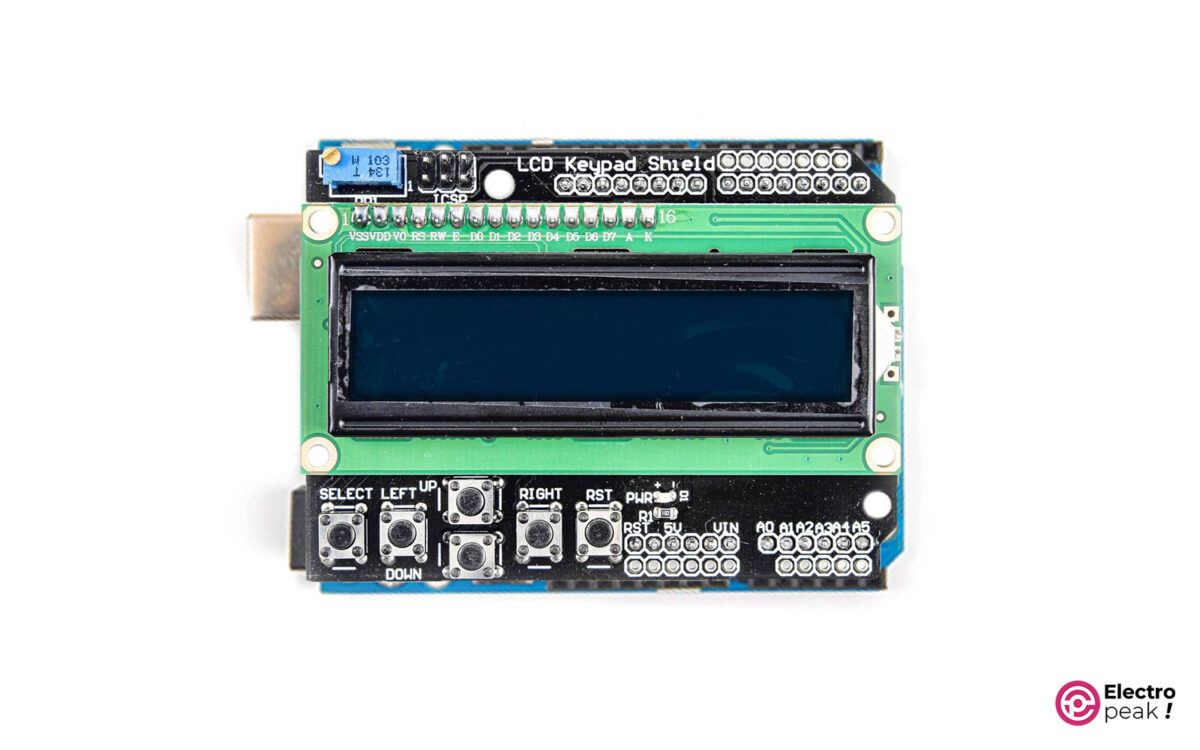
The RST button is also used to reset the game.
Selecting options and starting the game is also done with the SELECT button.
Step 2: Code
Then, after connecting the Arduino Board to the computer, upload the following code to it.
/*
Made on 01 Sep 2021
Home
*/
#include
byte mySnake[8][8] =
{
{ B00000,
B00000,
B00011,
B00110,
B01100,
B11000,
B00000,
},
{ B00000,
B11000,
B11110,
B00011,
B00001,
B00000,
B00000,
},
{ B00000,
B00000,
B00000,
B00000,
B00000,
B11111,
B01110,
},
{ B00000,
B00000,
B00011,
B01111,
B11000,
B00000,
B00000,
},
{ B00000,
B11100,
B11111,
B00001,
B00000,
B00000,
B00000,
},
{ B00000,
B00000,
B00000,
B11000,
B01101,
B00111,
B00000,
},
{ B00000,
B00000,
B01110,
B11011,
B11111,
B01110,
B00000,
},
{ B00000,
B00000,
B00000,
B01000,
B10000,
B01000,
B00000,
}
};
boolean levelz[5][2][16] = {
{{false,false,false,false,false,false,false,false,false,false,false,false,false,false,false,false},
{false,false,false,false,false,false,false,false,false,false,false,false,false,false,false,false}},
{{true,false,false,false,false,false,false,false,false,false,false,false,false,false,false,true},
{true,false,false,false,false,false,false,false,false,false,false,false,false,false,false,true}},
{{true,false,false,false,true,false,false,false,false,false,false,true,false,false,false,true},
{true,false,false,false,false,false,false,false,true,false,false,false,false,false,false,true}},
{{true,false,true,false,false,false,false,false,false,true,false,false,false,true,false,false},
{false,false,false,false,true,false,false,true,false,false,false,true,false,false,false,true}}
};
LiquidCrystal lcd(8, 9, 4, 5, 6, 7);
unsigned long time, timeNow;
int gameSpeed;
boolean skip, gameOver, gameStarted;
int olddir;
int selectedLevel,levels;
int adc_key_val[5] ={50, 200, 400, 600, 800 };
int NUM_KEYS = 5;
int adc_key_in;
int key=-1;
int oldkey=-1;
boolean x[16][80];
byte myChar[8];
byte nullChar[8] = { 0x0,0x0,0x0,0x0,0x0,0x0,0x0,0x0 };
boolean special;
struct partdef
{
int row,column,dir; //0 - up, 1 - down, 2 - right, 3 - left
struct partdef *next;
};
typedef partdef part;
part *head, *tail;
int i,j,collected;
long pc,pr;
void drawMatrix()
{
int cc=0;
if (!gameOver)
{
x[pr][pc] = true;
//for (i=0;i<8;i++) lcd.createChar(i, nullChar);
for(int r=0;r<2;r++)
{
for(int c=0;c<16;c++)
{
special = false;
for(int i=0;i<8;i++)
{
byte b=B00000;
if (x[r*8+i][c*5+0]) {b+=B10000; special = true;}
if (x[r*8+i][c*5+1]) {b+=B01000; special = true;}
if (x[r*8+i][c*5+2]) {b+=B00100; special = true;}
if (x[r*8+i][c*5+3]) {b+=B00010; special = true;}
if (x[r*8+i][c*5+4]) {b+=B00001; special = true;}
myChar[i] = b;
}
if (special)
{
lcd.createChar(cc, myChar);
lcd.setCursor(c,r);
lcd.write(byte(cc));
cc++;
}
else
{
lcd.setCursor(c,r);
if (levelz[selectedLevel][r][c]) lcd.write(255);
else lcd.write(254);
}
}
}
}
}
void freeList()
{
part *p,*q;
p = tail;
while (p!=NULL)
{
q = p;
p = p->next;
free(q);
}
head = tail = NULL;
}
void gameOverFunction()
{
delay(1000);
lcd.clear();
freeList();
lcd.setCursor(3,0);
lcd.print("Game Over!");
lcd.setCursor(4,1);
lcd.print("Score: ");
lcd.print(collected);
delay(1000);
}
void growSnake()
{
part *p;
p = (part*)malloc(sizeof(part));
p->row = tail->row;
p->column = tail->column;
p->dir = tail->dir;
p->next = tail;
tail = p;
}
void newPoint()
{
part *p;
p = tail;
boolean newp = true;
while (newp)
{
pr = random(16);
pc = random(80);
newp = false;
if (levelz[selectedLevel][pr / 8][pc / 5]) newp=true;
while (p->next != NULL && !newp)
{
if (p->row == pr && p->column == pc) newp = true;
p = p->next;
}
}
if (collected < 13 && gameStarted) growSnake();
}
void moveHead()
{
switch(head->dir) // 1 step in direction
{
case 0: head->row--; break;
case 1: head->row++; break;
case 2: head->column++; break;
case 3: head->column--; break;
default : break;
}
if (head->column >= 80) head->column = 0;
if (head->column < 0) head->column = 79;
if (head->row >= 16) head->row = 0;
if (head->row < 0) head->row = 15;
if (levelz[selectedLevel][head->row / 8][head->column / 5]) gameOver = true; // wall collision check
part *p;
p = tail;
while (p != head && !gameOver) // self collision
{
if (p->row == head->row && p->column == head->column) gameOver = true;
p = p->next;
}
if (gameOver)
gameOverFunction();
else
{
x[head->row][head->column] = true;
if (head->row == pr && head->column == pc) // point pickup check
{
collected++;
if (gameSpeed < 25) gameSpeed+=3;
newPoint();
}
}
}
void moveAll()
{
part *p;
p = tail;
x[p->row][p->column] = false;
while (p->next != NULL)
{
p->row = p->next->row;
p->column = p->next->column;
p->dir = p->next->dir;
p = p->next;
}
moveHead();
}
void createSnake(int n) // n = size of snake
{
for (i=0;i<16;i++)
for (j=0;j<80;j++)
x[i][j] = false;
part *p, *q;
tail = (part*)malloc(sizeof(part));
tail->row = 7;
tail->column = 39 + n/2;
tail->dir = 3;
q = tail;
x[tail->row][tail->column] = true;
for (i = 0; i < n-1; i++) // build snake from tail to head
{
p = (part*)malloc(sizeof(part));
p->row = q->row;
p->column = q->column - 1; //initial snake id placed horizoltally
x[p->row][p->column] = true;
p->dir = q->dir;
q->next = p;
q = p;
}
if (n>1)
{
p->next = NULL;
head = p;
}
else
{
tail->next = NULL;
head = tail;
}
}
void startF()
{
gameOver = false;
gameStarted = false;
selectedLevel = 1;
lcd.clear();
lcd.setCursor(0,0);
lcd.print("Select level: 1");
for(i=0;i<8;i++)
{
lcd.createChar(i,mySnake[i]);
lcd.setCursor(i+4,1);
lcd.write(byte(i));
}
collected = 0;
gameSpeed = 8;
createSnake(3);
time = 0;
}
void setup()
{
levels = 5; //number of lvls
lcd.begin(16, 2);
startF();
}
void loop()
{
if (!gameOver && !gameStarted)
{
adc_key_in = analogRead(0); // read the value from the sensor
key = get_key(adc_key_in); // convert into key press
if (key != oldkey) // if keypress is detected
{
delay(50); // wait for debounce time
adc_key_in = analogRead(0); // read the value from the sensor
key = get_key(adc_key_in); // convert into key press
if (key != oldkey)
{
oldkey = key;
if (key >=0)
{
olddir = head->dir;
if (key==1 && selectedLevel1) selectedLevel--;
if (key==4)
{
lcd.clear();
selectedLevel--;
newPoint();
gameStarted = true;
}
else
{
lcd.setCursor(14,0);
lcd.print(selectedLevel);
}
}
}
}
}
if (!gameOver && gameStarted)
{
skip = false; //skip the second moveAll() function call if the first was made
adc_key_in = analogRead(0); // read the value from the sensor
key = get_key(adc_key_in); // convert into key press
if (key != oldkey) // if keypress is detected
{
delay(50); // wait for debounce time
adc_key_in = analogRead(0); // read the value from the sensor
key = get_key(adc_key_in); // convert into key press
if (key != oldkey)
{
oldkey = key;
if (key >=0)
{
olddir = head->dir;
if (key==0 && head->dir!=3) head->dir = 2;
if (key==1 && head->dir!=1) head->dir = 0;
if (key==2 && head->dir!=0) head->dir = 1;
if (key==3 && head->dir!=2) head->dir = 3;
if (olddir != head->dir)
{
skip = true;
delay(1000/gameSpeed);
moveAll();
drawMatrix();
}
}
}
}
if (!skip)
{
timeNow = millis();
if (timeNow - time > 1000 / gameSpeed)
{
moveAll();
drawMatrix();
time = millis();
}
}
}
if(gameOver)
{
adc_key_in = analogRead(0); // read the value from the sensor
key = get_key(adc_key_in); // convert into key press
if (key != oldkey) // if keypress is detected
{
delay(50); // wait for debounce time
adc_key_in = analogRead(0); // read the value from the sensor
key = get_key(adc_key_in); // convert into key press
if (key != oldkey)
{
oldkey = key;
if (key >=0)
{
startF();
}
}
}
}
}
int get_key(unsigned int input)
{
int k;
for (k = 0; k < NUM_KEYS; k++)
{
if (input < adc_key_val[k])
{
return k;
}
}
if (k >= NUM_KEYS)k = -1; // No valid key pressed
return k;
}
With the program above, you can play the Snake game on the display with the buttons on the LCD shield.
Step 3: Enjoy the Game!
Now, after uploading the program, you can start playing the game.
The game starts by pressing the “Select” button and selecting the game level. And it does not end until the snake’s head touches its body.
The video below shows how to play the game.
What’s Next?
After completing this tutorial, you can do the following projects as the next step.
• Use OLEDs and other LCDs
• Run other games with the Arduino and MAX7219 8×8 Dot Matrix Display Module
• Use the 64-bit square RGB WS2812 Matrix

